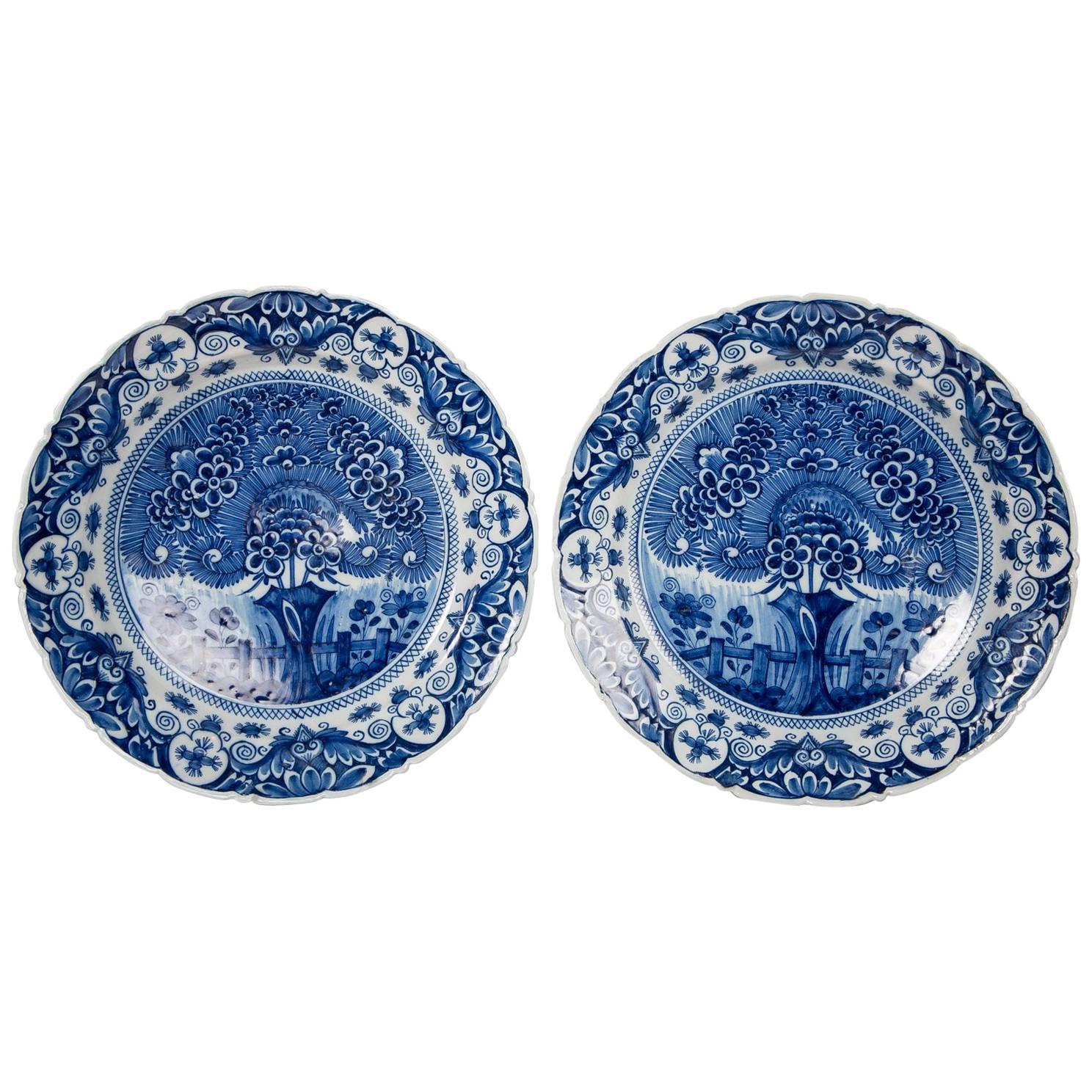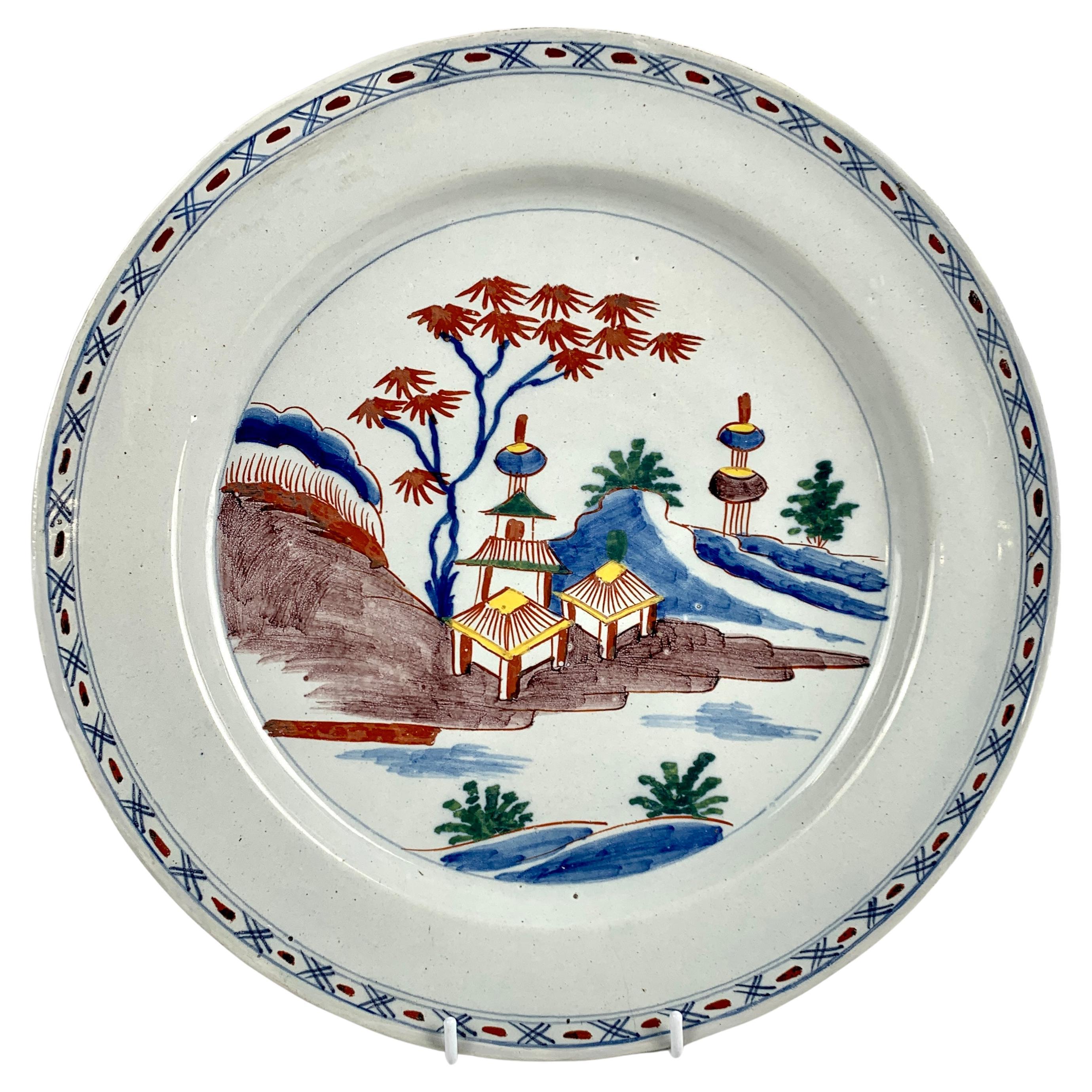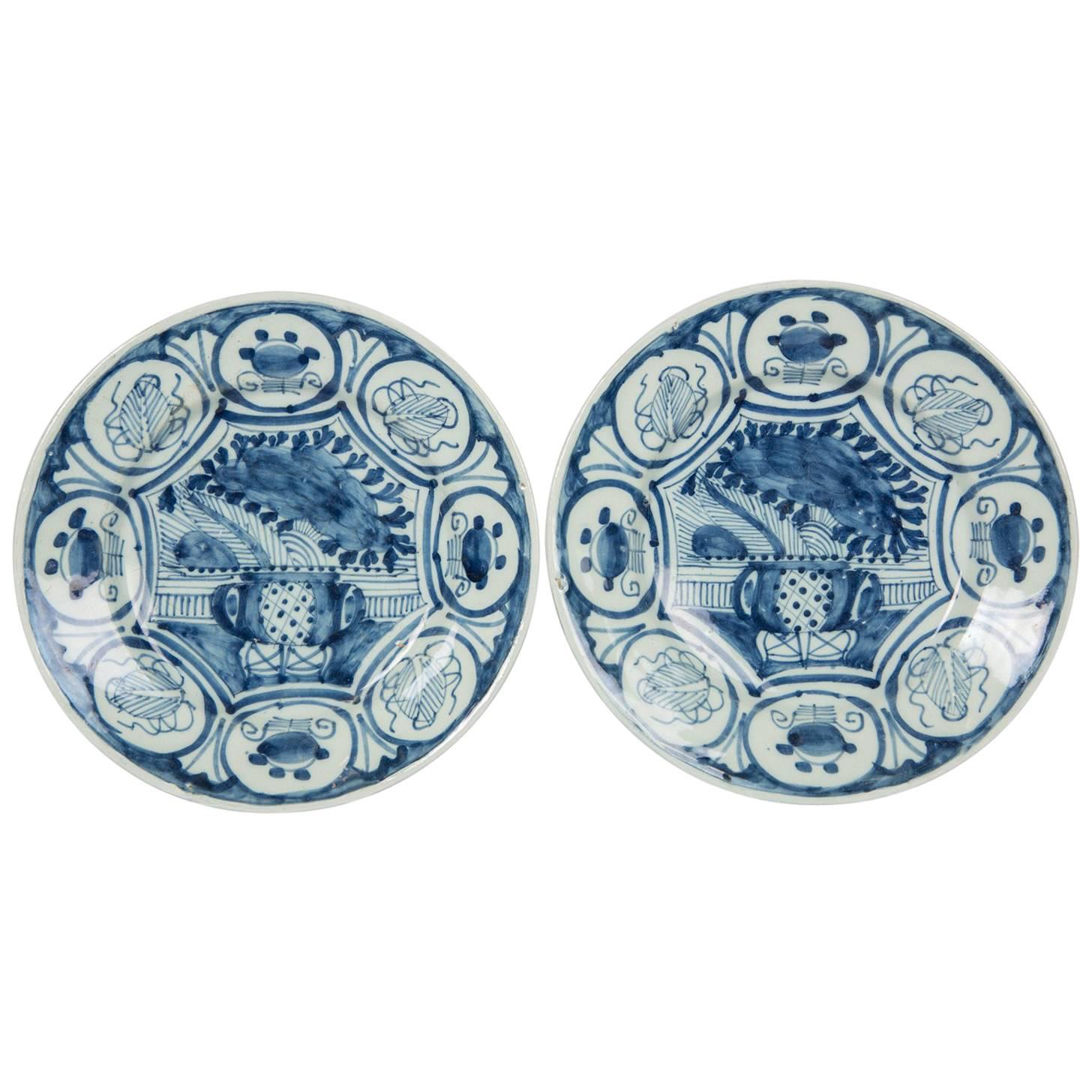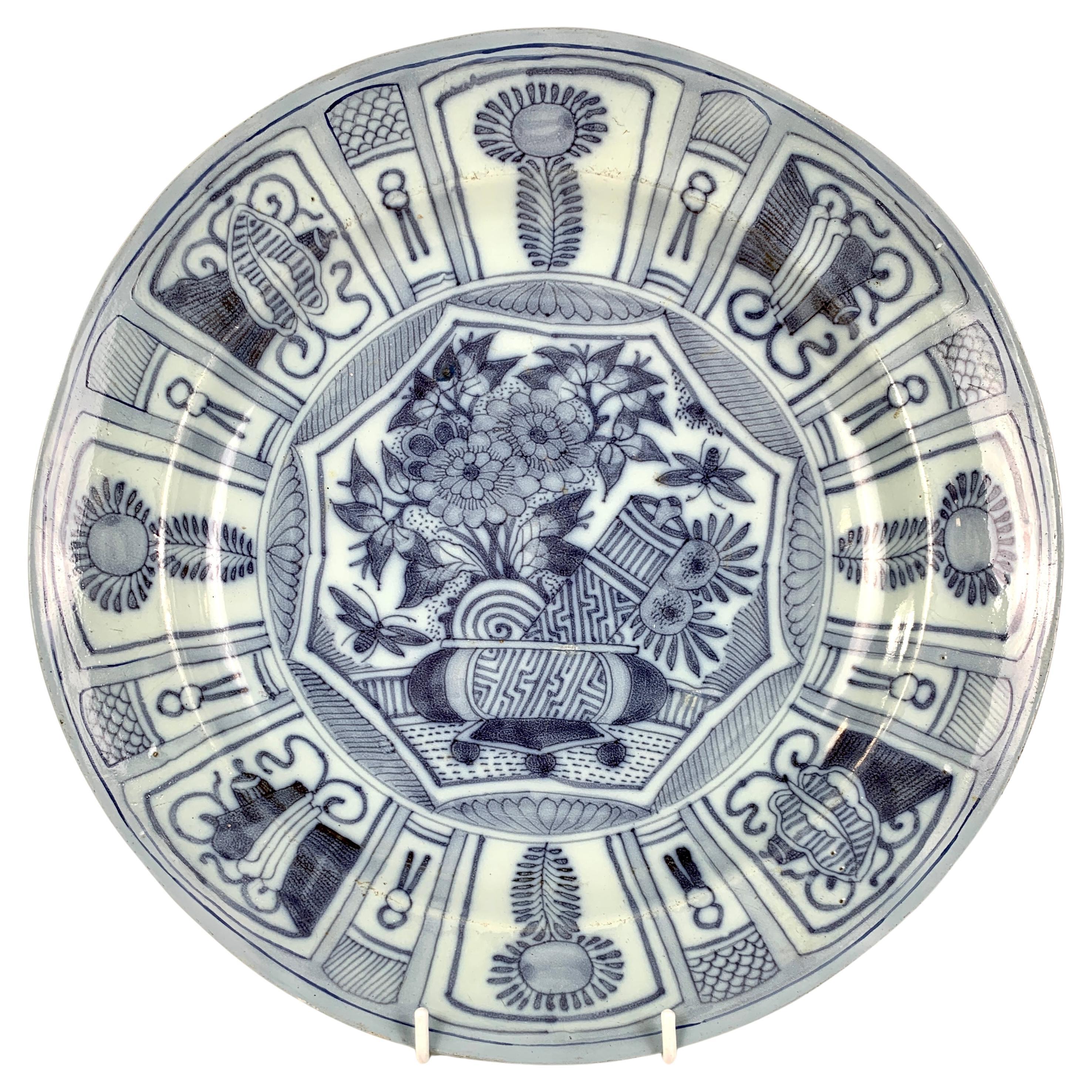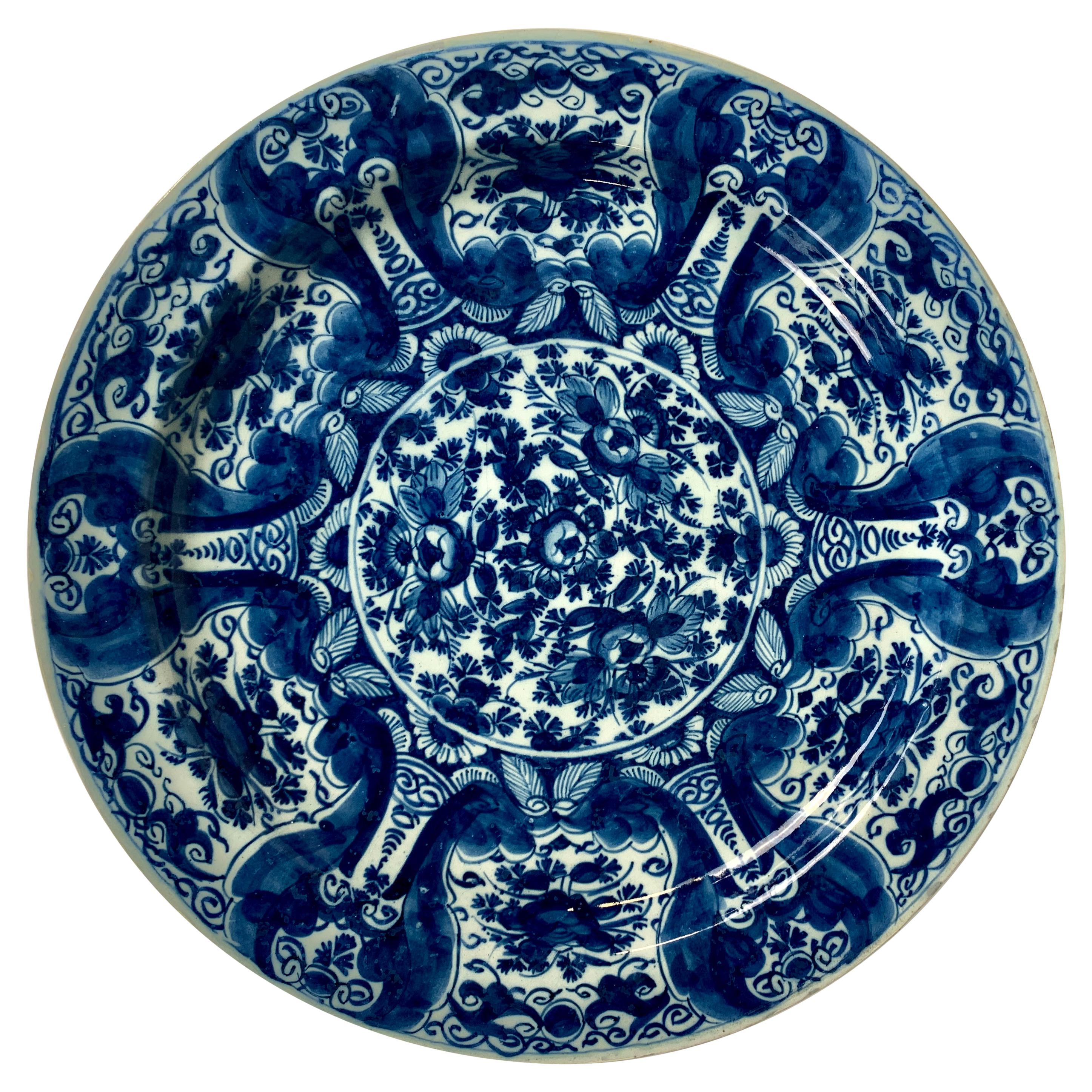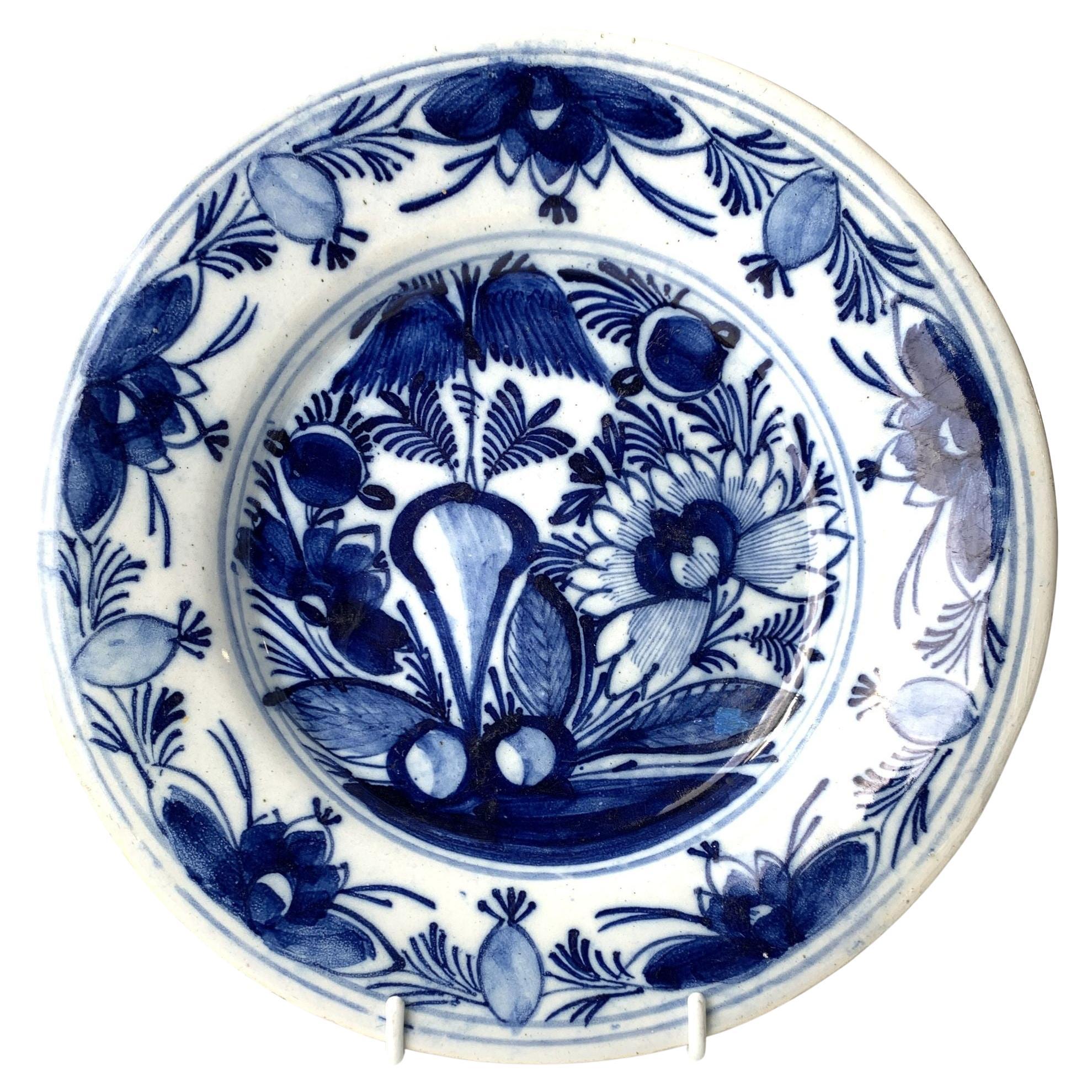Items Similar to Blue and White Delft Charger Made Netherlands circa 1770 Chinoiserie Decoration
Want more images or videos?
Request additional images or videos from the seller
1 of 9
Blue and White Delft Charger Made Netherlands circa 1770 Chinoiserie Decoration
About the Item
This blue and white Dutch Delft charger shows a chinoiserie scene in a lovely naive style.
The chinoiserie scene in the center of the charger includes three unique viewpoints.
On one side, we see a flower and buds in a vase.
On the other side, we see stacks of water with pagodas at the water's edge.
The third image is a pair of mountains sketched below the two scenes.
Seeing the three viewpoints at the same time is exciting.
Dimensions: 13.5" x 2.25" height
Condition: Excellent with slight edge frits invisibly restored
Price: $960
Background of Delft:
The technique of making Delft was first described in writing by Gerrit Paape in "The Delft Pottery Maker," written in 1794 and dedicated to Lambertus Sanderus, the owner of De Porceleyne Claeuw (The Porcelain Claw). Delft faience began in the 17th century. Much of the most beautiful Delft was produced in the Dutch city of Delft. The Delft potters began to coat their pots thoroughly in a white tin glaze. They then covered the white tin-glaze with a clear glaze, giving depth to the fired surface and smoothness to cobalt blues. Over time they created a good resemblance to porcelain. By circa 1650, the technical skills of the potters and painters were much improved, and Delft began its golden age.
- Dimensions:Height: 2.25 in (5.72 cm)Diameter: 13.5 in (34.29 cm)
- Materials and Techniques:
- Period:
- Date of Manufacture:circa 1770
- Condition:
- Seller Location:Katonah, NY
- Reference Number:
About the Seller
5.0
Recognized Seller
These prestigious sellers are industry leaders and represent the highest echelon for item quality and design.
Platinum Seller
These expertly vetted sellers are 1stDibs' most experienced sellers and are rated highest by our customers.
Established in 1962
1stDibs seller since 2009
422 sales on 1stDibs
Typical response time: 1 hour
- ShippingRetrieving quote...Ships From: Katonah, NY
- Return PolicyA return for this item may be initiated within 30 days of delivery.
More From This SellerView All
- Blue and White Delft Chargers Theeboom Pattern made by "The Claw" circa 1770By De KlaauwLocated in Katonah, NYThis pair of Dutch Delft chargers in the "Theeboom" pattern shows a tea plant with a fan-shaped bouquet of leaves and flowers. The deep cobalt blue is fabulous! This is one of the ...Category
Antique 1770s Dutch Rococo Delft and Faience
MaterialsDelft
- Antique Delft Charger 18th Century Polychrome Colors Netherlands Circa 1770Located in Katonah, NYThis antique Dutch Delft charger was hand painted in the 18th century, circa 1770. The center of this large Dutch Delft charger shows a lovely chinoiserie scene painted in vibrant p...Category
Antique Late 18th Century Dutch Chinoiserie Decorative Dishes and Vide-P...
MaterialsDelft
- Blue and White Delft Dishes Antique Pair Made circa 1770Located in Katonah, NYWe are pleased to offer this pair of blue and white Dutch Delft dishes with lovely chinoiserie decoration, which features an image of a vase overflowing with flowers. Around the vas...Category
Antique 1770s Dutch Chinoiserie Decorative Dishes and Vide-Poche
MaterialsDelft
- Blue and White Delft Charger Hand Painted Netherlands 17th Century, Circa 1685Located in Katonah, NYThis blue and white Delft charger was hand-painted with a chinoiserie scene in the late 17th century. The decoration style was taken directly from Kraak porcelain...Category
Antique Late 17th Century Dutch Qing Decorative Dishes and Vide-Poche
MaterialsDelft
- Blue and White Delft Charger Hand-Painted, Netherlands, 18th Century, Circa 1760Located in Katonah, NYThe entire surface of this blue and white Dutch Delft charger is covered in deep beautiful cobalt blue coloring. The center of the charger is filled with lovely hand-painted peonies...Category
Antique Mid-18th Century Dutch Rococo Delft and Faience
MaterialsDelft
- Blue and White Delft Dish Netherlands Circa 1800Located in Katonah, NYAt the center of this lovely hand-painted blue and white Delft dish is a traditional chinoiserie view of a garden. We see an oversized peony, a willow tree...Category
Antique Early 19th Century Delft and Faience
MaterialsDelft
You May Also Like
- Delft, Blue and White Chinoiserie Altar Vase, circa 1685By Dutch OriginalsLocated in Verviers, BEBlue and white chinoiserie altar vase. Delft, circa 1685 The ovoid altar vase stands on a high-waisted foot. The flaring cylindrical neck ends in an outward sloping mouth rim. The two blue coloured lion-shaped handles have suspending rings in their jaws. The body is painted with a continuous oriental landscape with banana and pine trees, Chinese figures and houses, while the neck is painted with three bands of different ornaments. The mouth rim is decorated with rectangular ornaments, the foot with leaves under a band around the ankle. Altar vases are also called vases à chimères. The oldest faience examples were made in the sixteen-twenties in Nevers, France and are attributed to the Conrade potters family, who originated from Italy. The shape is based on metal vases used during the services in Catholic churches. Therefore it is no wonder that many altar vases are painted with the Christogram IHS. Altar vases were made in Delft from about 1675 onwards and production continued well into the eighteenth century. Marked examples are known from multiple manufacturers, such as The Greek A and The Moor’s Head potteries (Aronson 2011, pp. 14-15). A pair of eighteenth century vases was made between 1700 and 1716 at The Three Porcelain Ash Barrells pottery. They are marked with PK for the owner Pieter Kam or, after 1705, by his widow (Blazy & Boyazoglu 1983, p. 110). The pair is painted with a dense parsley decor. A miniature example was excavated from a cesspit in the grounds of the former Porcelain Bottle pottery in Delft. At the same location a larger fragment was also found, decorated with a triple-tulip design in blue and yellow (Eliëns, Schledorn, Van Aken-Fehmers, pp. 31 , 36, 45). Three altar vases with similar tulip and flower decoration in blue and yellow are in the collection of the Dutch Open Air Museum in Arnhem and can also be attributed to the Porcelain Bottle pottery (Klein, p. 152). Official Catholic services were not allowed in the seventeenth century in the Dutch republic, however Catholic conventicles were tolerated. At first sight it might be surprising that a Catholic object...Category
Antique Late 17th Century Dutch Baroque Delft and Faience
MaterialsCeramic, Faience
- Blue and White Delft Handled Chinoiserie VaseBy DelftLocated in New York, NYBlue and white Delft handled chinoiserie vase. Antique Dutch porcelain vase with rich blue flowers and chinoiserie fencing in a lustrous glaze; with scro...Category
Antique Late 18th Century Dutch Chinoiserie Delft and Faience
MaterialsCeramic
- Delft, Blue and White floral Chinoiserie Jar, 1650-1680By Dutch OriginalsLocated in Verviers, BEThe ovoid jar stands on a slightly spreading foot, has a short upright neck, and is painted in blue with a floral decor. Three large cartouches containing flower bouquets have been a...Category
Antique 17th Century Dutch Baroque Delft and Faience
MaterialsCeramic, Faience
- Delft, Purple and Yellow Chinoiserie Jug, circa 1680-1700By Dutch OriginalsLocated in Verviers, BEPurple and yellow chinoiserie jug. Delft, circa 1680 - 1700 The ovoid jug stands on a lightly spreading foot and has a tapered neck with spout. The top of the handle is pierced for a metal mount. The jug is painted in purple and yellow with a continuous chinoiserie landscape with Chinese figures. Bands with rectangular ornaments between double circles are applied on the shoulder and just above the foot. The neck is painted with a double leaf motif. The handle is decorated with stripes and dots, alternately applied in purlple and yellow. Purple or multi-coloured Delftware with chinoiserie landscapes are relatively rare, though versions in blue and purple, blue and yellow, green and purple are known, as well as three colour combinations like purple, yellow and green. A butter pot in this last colour combination was excavated from a cesspit in the grounds of the former Porcelain Bottle pottery in Delft. Multi-coloured chinoiserie decorations are painted especially on lobed dishes and also on beer mugs, covered spiced wine bowls and small plates. A purple, yellow and green painted beer mug in the Princessehof Ceramics Museum in Leeuwarden, The Netherlands, combines a chinoiserie landscape with a depiction of stadtholder prins Willem III...Category
Antique Late 17th Century Dutch Baroque Delft and Faience
MaterialsCeramic, Faience
- 18th c. Dutch Delft Lobed Sweetmeat DishLocated in Greenwich, CTAn early and rare 18th century Dutch Delft sweetmeat dish having eggyolk and soft gray-blue overall decorative design with a depiction of a lady sitting...Category
Antique 18th Century and Earlier Dutch Decorative Bowls
MaterialsCeramic
- 19th Century French Faience Charger or PlateLocated in Hamilton, Ontario19th century French faience charger or plate with Gien mark.Category
Antique 19th Century French Decorative Dishes and Vide-Poche
Recently Viewed
View AllMore Ways To Browse
Antique Kitchen Images
Images Of Antique Kitchens
Beautiful Antique White Kitchens
Antique Pottery Makers
Blue White Pot
Blue And White Pot
Blue And White Pots
Antique White Pot
Chinoiserie Blue White
Blue And White Chinoiserie
Blue And White 18th Century Delft
18th Century Firing Glass
Blue And White Water Glass
Blue Glass Charger
Delfts Blue Pair
Blue White Charger
Blue And White Chargers
Antique Delft Porcelain
